Affiliate links on Android Authority may earn us a commission. Learn more.
Samsung Galaxy M40 vs Galaxy A50: A clear outcome
Published onSeptember 29, 2019
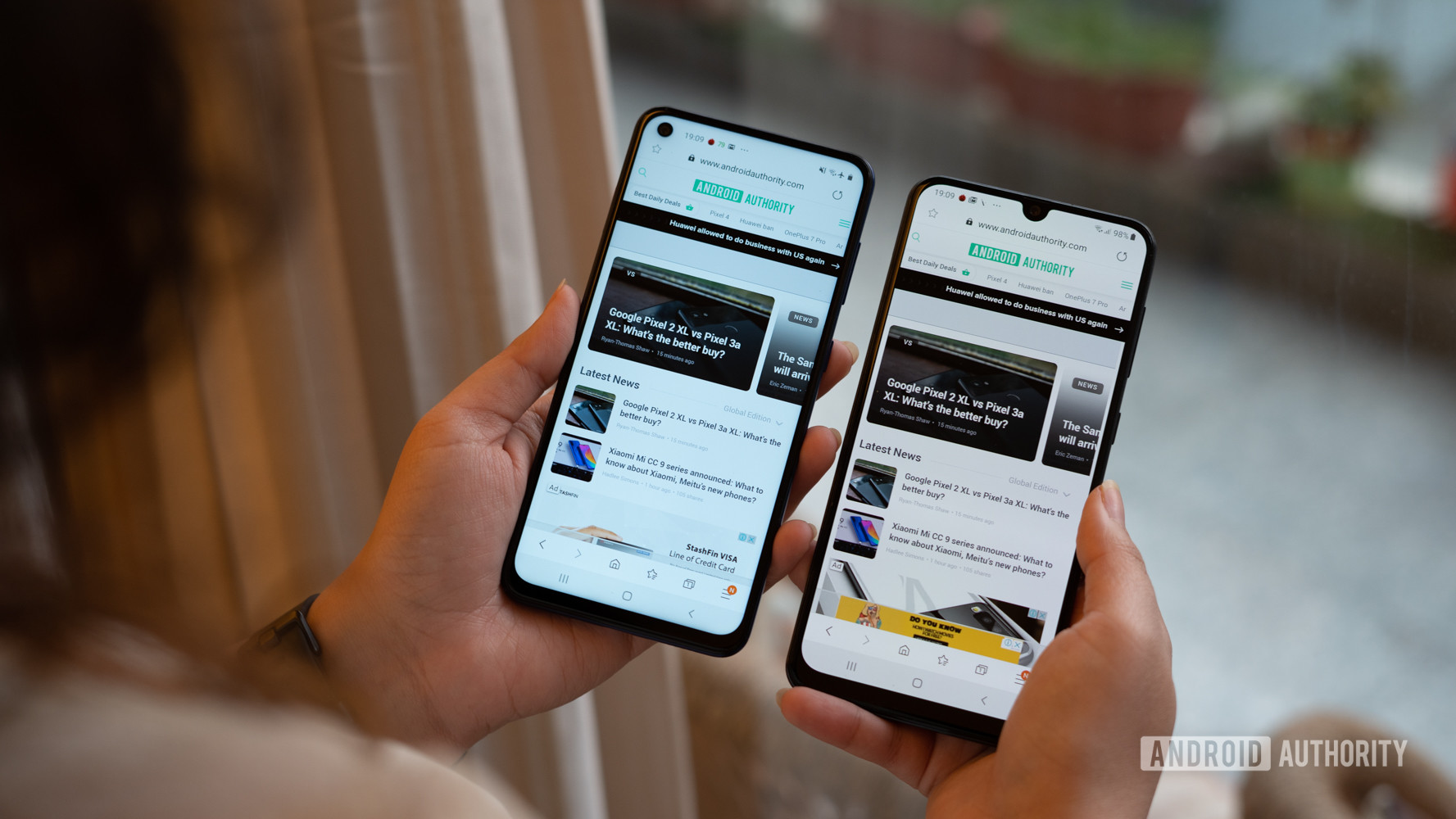
Update: September 29, 2019 – You can get the Galaxy A50 for free, with an eligible phone trade-in, at Samsung’s official site. This offer ends October 31.
Samsung is back in a big way in the budget-friendly segment. A segment that it had seemingly given up on until recently, there are now four smartphones in the new M series and six out of the seven Galaxy A phones have already made their way to India. The Samsung Galaxy M40 and the Galaxy A50 come with similar features, specifications, and price points. With the pricing so close, this raises the obvious question: What is the difference between the Galaxy M40 and the A50, and is one better than the other?
We take a closer look in our Samsung Galaxy M40 vs Galaxy A50 comparison!
Design
Samsung Galaxy M40
- Polycarbonate
- 155.3 x 73.9 x 7.9mm
- 168g
- Infinity-O (punch hole) display
Samsung Galaxy A50
- Polycarbonate
- 158.5 x 74.7 x 7.7mm
- 166g
- Teardrop “U” notch
The Galaxy M40 and the Galaxy A50 both sport polycarbonate bodies. A glossy finish with gradient colors give them a premium look, but neither looks or feels as good as a smartphone made of glass. The two are equally prone to collect scuffs, fingerprints, and scratches, so it’ll be wise to invest in a protective case.
Thanks to the near-identical dimensions and placement of the rear cameras, the phones look similar from the rear. The gradient patterns help set them apart. The M40 boasts a somewhat unique look with the gradient pattern falling off along the edges. Conversely, the A50’s pattern is a straightforward top-to-bottom fade.
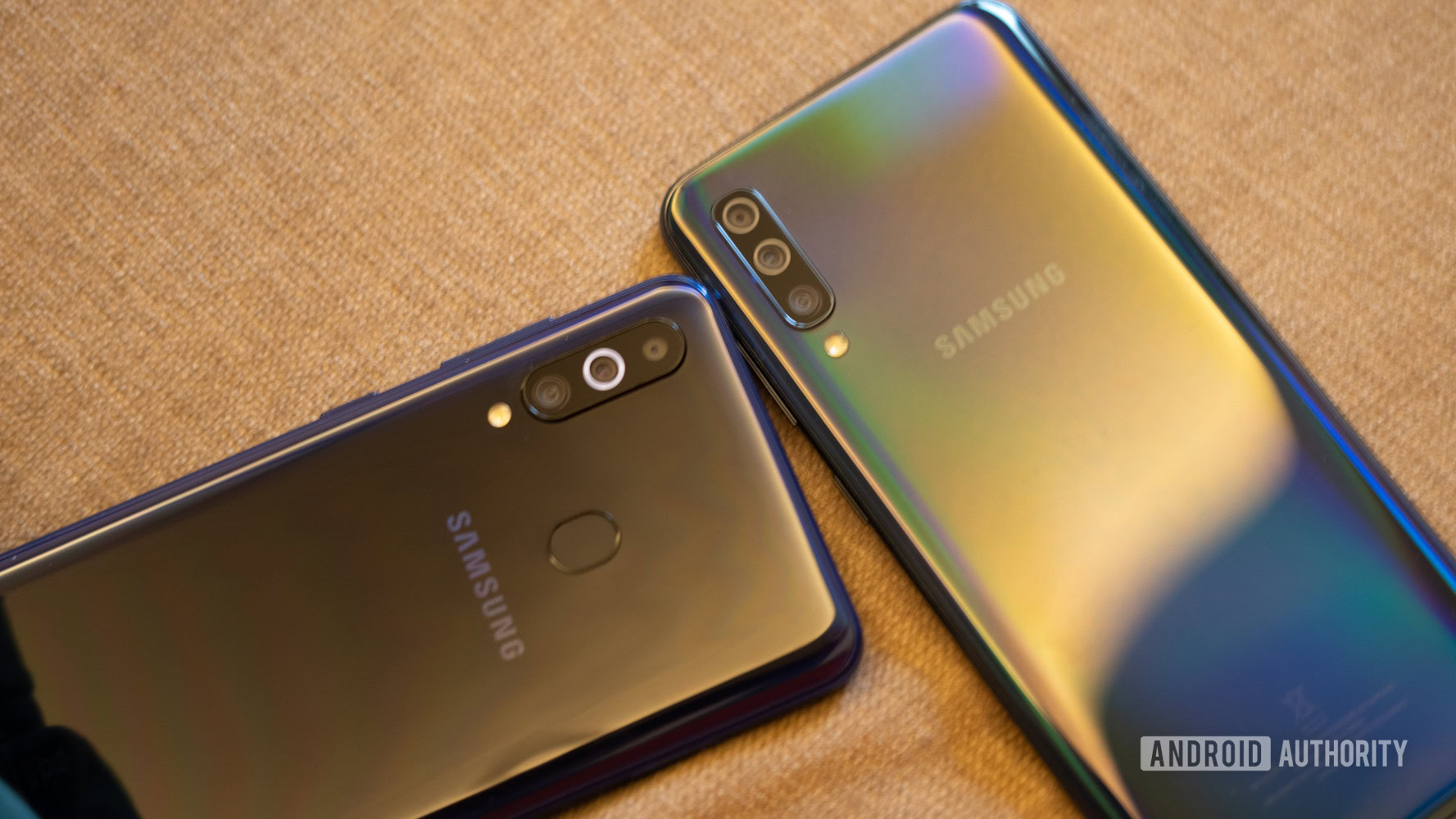
Samsung got rid of the regular fingerprint scanner for the Galaxy A50 in favor of an in-display sensor. All the cool kids are doing it, but there’s something to be said for the tried and tested. Unsurprisingly, the rear scanner of the Galaxy M40 is faster than that of the Galaxy A50. Both phones support software-based Face Unlock as well.
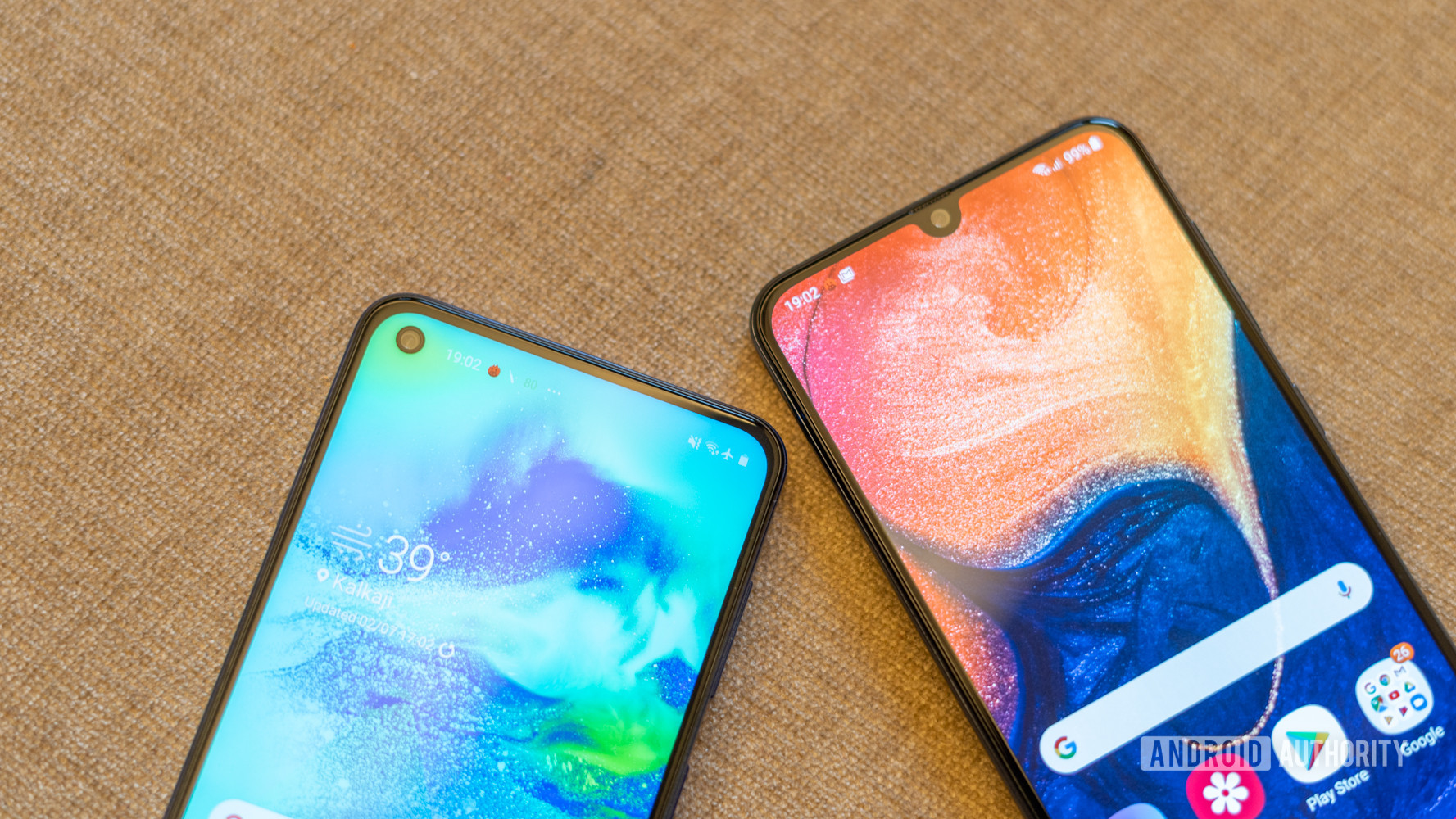
The major difference in design is up front. The Galaxy A50 sticks to an old-school teardrop notch. The Galaxy M40, on the other hand, brings Samsung’s flagship design language to the mid-range with the punch hole design. The first phone to carry an Infinity-O punch-hole design in this price range, the M40 offers a great way to stand out in a sea of similar looking smartphones.
While the Galaxy M40 gets points for being unique, Samsung knows how to make a good-looking and ergonomic smartphone and neither device is going to leave you disappointed in terms of design and build quality.
Display
Samsung Galaxy M40
- 6.3-inch IPS LCD
- Full HD+
Samsung Galaxy A50
- 6.4-inch Super AMOLED
- Full HD+
The display on the Galaxy A50 is ever-so-slightly larger, but both phones have the same resolution. Despite these basic similarities, there’s a clear winner here: The Galaxy A50’s Super AMOLED display. That’s not to say that the LCD panel of the M40 is bad in any way. It’s probably one of the better LCDs around compared to some of the competition. The AMOLED screen of the A50 is simply nicer to look at. The colors are punchier, the blacks are deeper, and it’s a touch brighter, too.
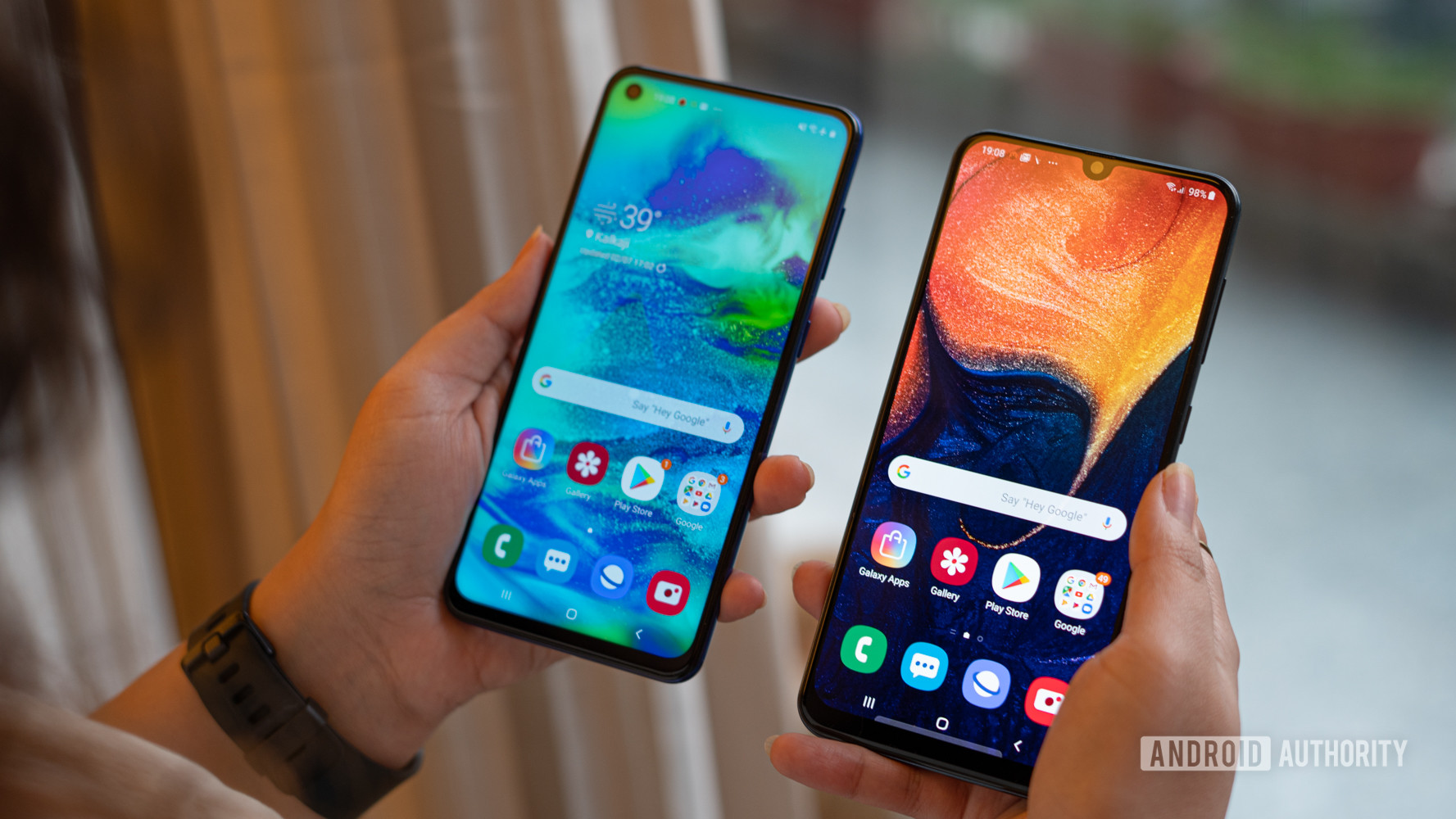
Some may question the reason Samsung didn’t go the AMOLED route with the Galaxy M40 in the first place. After all, the cheaper Galaxy M30 comes with one and the Galaxy A50 isn’t that much more expensive than the M40. It’s likely the inclusion of the punch hole in the display that caused this switch. Yes, the Galaxy S10 series has the same Infinity-O design on an AMOLED panel, but those phones are also four times the price.
It’s aesthetics vs quality in consideration here. The Galaxy M40 display is definitely not going to disappoint anyone. You also get to enjoy a unique look, and the punch hole isn’t as intrusive as the teardrop notch when watching videos or playing games. That said, the display crown goes to the Galaxy A50.
Performance
Samsung Galaxy M40
- Snapdragon 675
- 6GB RAM
- 128GB storage
Samsung Galaxy A50
- Exynos 9610
- 4GB or 6GB RAM
- 64GB storage
The Samsung Galaxy A50 comes with an in-house Exynos processor, while the Galaxy M40 is powered by a premium mid-range staple, the Snapdragon 675. Either way, both phones can comfortably handle anything you throw at them. Performing day-to-day tasks and general multi-tasking is an absolute breeze. However, if it is power that you crave, the M40 proves to be the more powerful option. Even though both processors are very capable, Samsung’s much smoother software experience has a large role to play here as well. In our reviews, we found the Galaxy A50 to offer a slightly more optimized software experience.
AnTuTu
3D Mark
The Galaxy M40 has launched in India in a single variant with 6GB of RAM and 128GB of storage. Meanwhile, the Galaxy A50 version is available in both 4GB and 6GB variants, allowing you to save a bit of money if you just want that fabulous AMOLED display. Storage on the Galaxy A50 tops off at 64GB, but you can expand that via microSD card.
Hardware
Samsung Galaxy M40
- 3,500mAh battery
- No headphone jack
- MicroSD expansion up to 1TB
Samsung Galaxy A50
- 4,000mAh battery
- Headphone jack
- MicroSD expansion up to 1TB
The Galaxy M40 comes with a smaller battery, but the power efficiency of the Snapdragon 675 really shines through here. Ultimately, you get impressive battery life with both. These phones will easily last a full day, even with relatively heavy usage. With regular use, you will likely have enough power to go through half of the next day as well.
If not having a headphone jack is a deal breaker, the Galaxy M40 isn't for you.
One major difference in the hardware may be the make-or-break factor for many: The Galaxy M40 doesn’t sport a headphone jack. Instead, Samsung provides a USB-C headset in the box. If a 3.5mm jack is a must, the Galaxy A50 is the only way to go. It’s once again a rather odd decision by Samsung to leave it out of the M40, especially since the rest of the M-series devices have them.
Camera
Samsung Galaxy M40
- Rear:
- 32MP (f/1.7) primary
- 8MP ultrawide
- 5MP depth
- Front:
- 16MP (f/2.0)
Samsung Galaxy A50
- Rear:
- 25MP (f/1.7) primary
- 8MP ultrawide
- 5MP depth
- Front:
- 25MP (f/2.0)
The imaging capabilities of the Samsung Galaxy M40 and A50 are familiar yet different. Both phones pack 8MP ultrawide cameras as well as 5MP depth sensors. The primary cameras, however, are very different. The Galaxy M40’s primary 32MP sensor outputs 12MP pixel-binned shots. Theoretically, the M40 should deliver superior performance in low-light conditions.
In the outdoor sample, we see a stark difference in how the two phones approach color. The Galaxy M40 is decidedly brighter compared to the A50. You will also notice a hint of oversharpening. The M40’s images might please users who like adding filters to their images but the Galaxy A50’s images have a more natural look in comparison. Noticeably, HDR performance isn’t anything special on either device.
We see similar results in our indoor samples. The Galaxy M40’s images are ever-so-slightly over-sharpened and saturated.
Samsung Galaxy M40 Photo Gallery
Samsung Galaxy A50 Photo Gallery
Software
Samsung Galaxy M40
- Android 9.0 Pie
- Samsung One UI
Samsung Galaxy A50
- Android 9.0 Pie
- Samsung One UI
Both phones offer an identical software experience with Samsung’s One UI. Samsung had a very specific goal with its latest software package — to simplify everything and make it more visually appealing. The great news is that Samsung has managed to deliver on both counts.
Samsung's One UI simplifies everything and makes it more aesthetically pleasing.
There are a lot of new features, of course, including better gesture navigation, a system-wide dark mode, and easier one-handed usability. As far as the aesthetics are concerned, Samsung has completely overhauled the icons, the notification panel, and the Settings menu. The interface, in general, is much cleaner as well.
There’s going to be some bloatware, but Samsung makes it much easier for users to decide which Samsung apps they want to install. Unlike before, only a couple of pre-installed apps cannot be removed from the device. The Samsung One UI is a huge improvement over previous software iterations and contributes to the smooth performance of both phones.
Specs
| Samsung Galaxy M40 | Samsung Galaxy A50 | |
|---|---|---|
Display | Samsung Galaxy M40 6.3-inch IPS LCD Full HD+ | Samsung Galaxy A50 6.4-inch Super AMOLED Full HD+ |
Processor | Samsung Galaxy M40 2GHz octa-core Qualcomm Snapdragon 675 Adreno 612 GPU | Samsung Galaxy A50 2.3GHz octa-core Samsung Exynos 9610 Mali-G72 MP3 GPU |
RAM | Samsung Galaxy M40 6GB | Samsung Galaxy A50 4/6GB |
Storage | Samsung Galaxy M40 128GB expandable | Samsung Galaxy A50 64GB expandable |
Camera | Samsung Galaxy M40 Rear: 32MP standard 8MP ultra-wide 5MP depth Front: 16MP | Samsung Galaxy A50 Rear: 25MP standard 8MP ultra-wide 5MP depth Front: 25MP |
Battery | Samsung Galaxy M40 3,500mAh | Samsung Galaxy A50 4,000mAh |
Software | Samsung Galaxy M40 Android 9.0 Pie | Samsung Galaxy A50 Android 9.0 Pie |
Dimensions | Samsung Galaxy M40 155.3 x 73.9 x 7.9mm 168g | Samsung Galaxy A50 158.5 x 74.7 x 7.7mm 166g |
Pricing and final thoughts
Samsung Galaxy M40
- 19,990 rupees (~$290)
Samsung Galaxy A50
- 4GB RAM: 18,490 rupees (~$265)
- 6GB RAM: 21,490 rupees (~$310)
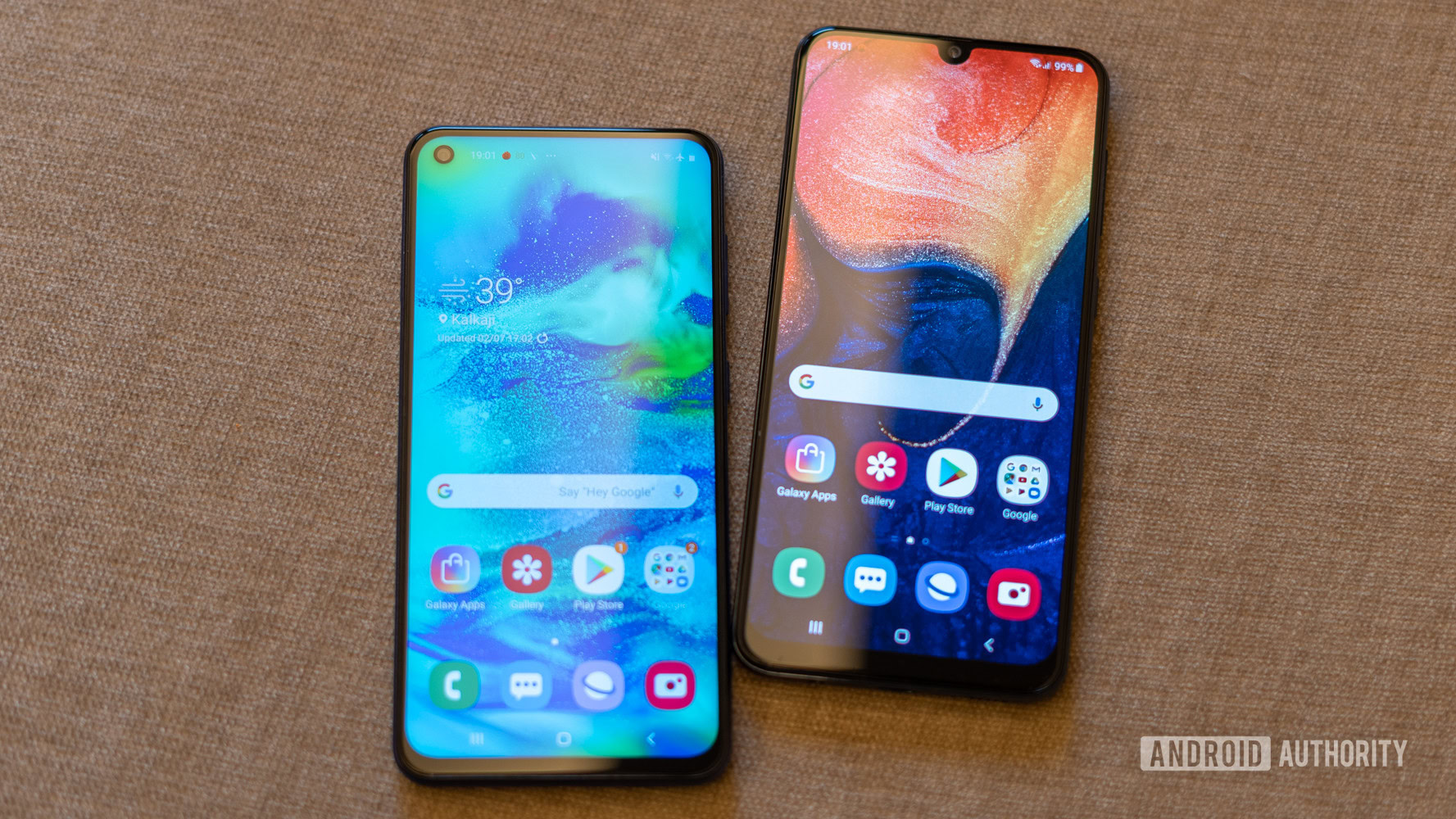
With the same amount of RAM, but with double the storage, the Galaxy M40 is 1,500 rupees (~$20) cheaper than the Galaxy A50. It’s not just about the price though, and there are quite a few key differences between the two. The M40 offers better performing internals with some rough edges around the software. The software isn’t quite as well optimized for the hardware, giving you dropped frames or the occasional lag. By no means is it a dealbreaker but the added level of polish on the A50 makes us veer towards it.
Meanwhile, the Galaxy A50 has a gorgeous AMOLED panel and a deeply refined user experience wrapped in a package that is bound to please all but the most demanding users.
Ultimately, it all depends on what you’re looking for from your smartphone experience. The differences are where your decision will lie. Want a unique look that you won’t get from most other smartphones in this price range? The Galaxy M40 is the phone for you. If a better display and, more importantly, a headphone jack is a must, then the Galaxy A50 should rank higher in your consideration. Which will you opt for?